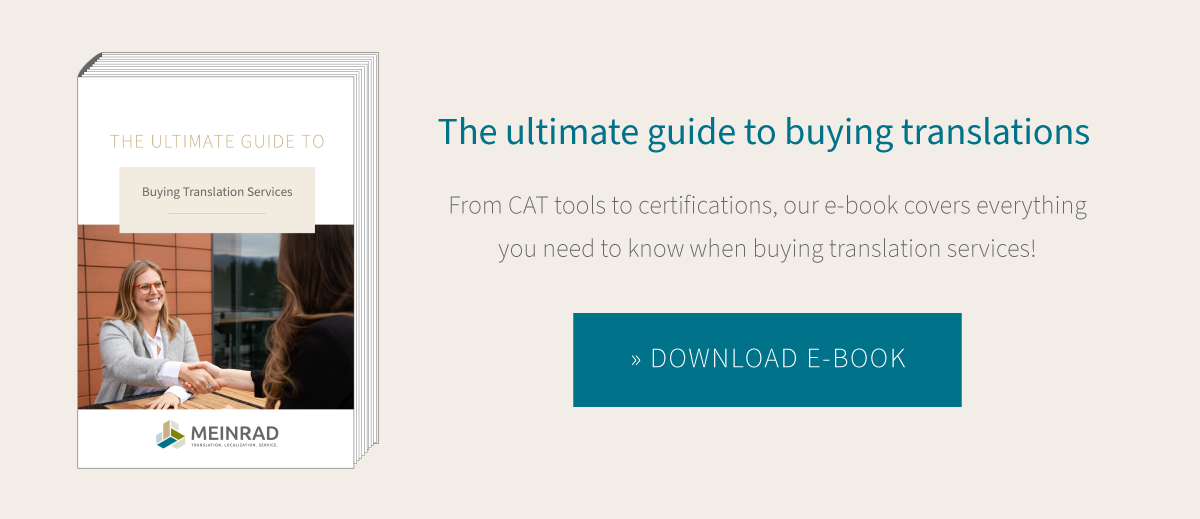
Have you ever sent a document with a very short paragraph for translation and wondered why this seemingly mini-project a) “takes so long” and b) “costs so much”? Translation agencies take the same amount of care over all translation projects – whether they’re 100 words, 1000 words or 100,000 words, the workflows and steps involved don’t change. And that means the level of work involved is similar. MEINRAD explains.
“Why does it take so long to translate three sentences?” is the kind of question many people who regularly order translations both long and short from their trusted translation agency may well have asked themselves. So let’s take this example: the issue is that although the three sentences themselves can be translated from one language to another pretty quickly, this is just one of many steps in the supply chain, the proverbial tip of the iceberg. People ordering translations often don’t realize just how many processes and steps are usually required in order to produce a high-quality translation. And these steps have a big impact on how long it takes to deliver a translation.
What a translation workflow involves
The days are long gone when translation agencies simply sent files straight to the translators for them to work on and return when they were done. Of course that could still happen, but it would prevent advanced translation technology (translation memory systems, term bases and so on) from being used. Agencies work with CAT tools, and in order for a project to run smoothly, the project manager needs to prepare everything before the text is assigned to the translator. This can include converting files that can’t be edited, creating the project, adding specific client term bases, configuring individual settings (e.g. choosing the right filter for the respective file, potentially adjusting the segmentation etc., locking or tagging sections which don’t need to be translated, and much more), and carrying out a detailed text analysis. In short, the project manager is the expert who creates the project and prepares everything so that all the text that needs to be translated can then be worked on by the translator.
The same amount of work for projects big and small
These steps have to happen, regardless of the size of the project. That means the time involved for a small project with a minimal word count is often not much shorter than for a larger project (depending on the file format and structure). And the more languages a project comprises, the more time it will take for the project manager to prepare the project – again, regardless of its size. That’s because each language has to be prepared separately, and the project manager needs to be in contact with a different translator for each language (to offer them the project, assign the text to them, answer any questions, etc.). So there’s a big difference between a project with one language and a project with 20, but whether there are 50 words or 5000 words to translate for each language actually has less of an impact.
The work done by the translator
When you get to the translation itself, clearly there’s a difference between translating a few sentences and translating several thousand words. But you shouldn’t underestimate the amount of work involved in small projects for translators. Compared to what they earn for jobs like these, they can have quite a lot to do: they have to accept the job offer, read the instructions, log in to the server and access the project, load and open it on their computer, work with resources such as term bases and translation memories to produce an accurate and coherent translation, carry out a quality assurance check, deliver the job and subsequently send an invoice. And bear in mind that it can often be difficult to translate texts with just a handful of words/sentences, as they have little or no context, meaning a lot more research may be required and they may have to rely more on existing translations in the translation memory and the term base. In some cases it can be harder than translating an entire set of operating instructions from top to bottom.
Covering the costs for translation agencies
Very short projects aren’t economical for translation agencies, as the price per word usually doesn’t cover the costs of a mini-translation. Let’s say you have a text of under 100 words to translate. Even if it’s a “simple”, editable file format, in total the project manager and the translator will probably spend at least an hour on it before it can be delivered (and if it needs to be translated into multiple languages, the project manager may well need several hours to get it done). Those costs aren’t covered by the price of a few cents per word, and the agency will definitely be out of pocket if each freelance translator charges a minimum rate to make it worth their while. So agencies usually charge their own minimum rates for small projects, or they might charge by the hour rather than by the word. These minimum rates are nothing to do with profiteering – they’re needed in order to cover the costs of working on small projects.
How to avoid minimum rates in translations
So minimum rates are needed to cover the costs of small projects. They probably can’t be completely avoided, as sometimes you only have a tiny amount to translate, but as often as possible, we recommend waiting to send projects to your translation agency until you have more text to be translated. Another top tip: talk to your agency, as you may be able to optimize your workflow. One way to save money might be smart automation, for example with project packages automatically created at regular intervals.
Main image © Adobe Stock


